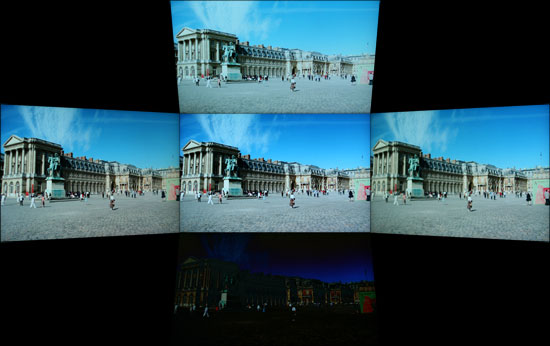Gateway FHD2400 Specifications and Appearance
| Gateway FHD2400 Specifications | |
| Video Inputs | DVI with HDCP support HDMI Analog (VGA) Component S-Video Composite |
| Panel Type | TN (GWY 0968) |
| Pixel Pitch | 0.270mm |
| Colors | 16.7 million (6-bit with
dithering/interpolation?) 92% color gamut |
| Brightness | 400 cd/m2 |
| Contrast Ratio | 1000:1 Static |
| Response Time | 3ms GTG with UltraResponse 5ms GTG without UltraResponse |
| Viewable Size | 24" diagonal |
| Resolution | 1920x1200 |
| Viewing Angle | 160 horizontal/vertical |
| Power Consumption | <150W max stated 76W max, 36W min measured |
| Power Savings | <2W |
| Screen Treatment | Glossy UltraBright |
| Height-Adjustable | Yes - 5.00 inches |
| Tilt | Yes - 25 degrees back/5 degrees forward |
| Pivot | Yes |
| Swivel | Yes - 360 degrees (with sufficient space) |
| VESA Wall Mounting | 100mm x 100mm |
| Dimensions w/ Base (WxHxD) | 22.48" x 17.36" x 9.92" lowered
(WxHxD) 22.48" x 22.36" x 9.92" raised (WxHxD) |
| Weight w/ Stand | 17.2 lbs. |
| Additional Features | (2) USB 2.0 - left, (2) USB 2.0 -
back (USB connection to PC required) Faroudja video processing |
| Audio | Optional speaker bar |
| Limited Warranty | 1-year parts and labor 3-year optional upgrades from Gateway ($30) |
| Price | MSRP $500 Online starting at ~$450 |
The Gateway FHD2400 is similar to the Dell 2408WFP in some ways: you get a bevy of input options and a fully functional stand. Move beyond that areas and there are plenty of differences. First, like the ASUS MK241H the FHD2400 uses a TN panel. Unlike all of the other LCDs in this roundup, the Gateway includes a glossy panel. You can easily see reflections in the LCD, particularly when it's off or showing dark content in a well-lit room, but in normal use it's not much of a problem. In fact, we can stop right now for those of you that like glossy displays: this is a great 24" LCD and definitely gets our recommendation for the glossy club. (However, there are a few other caveats that we will get to shortly.)
Gateway doesn't offer quite as many input options as Dell, but then we imagine the vast majority of users will only use one input anyway. Still, you get HDMI and DVI digital inputs, VGA for analog computer use, and component video in case you want to use the display as an HDTV. (Does anyone actually still use S-Video or composite inputs?)
 |
In some ways, the Gateway stand is the best of the bunch today. It has two small wheels on the bottom that allow you to rotate the display 360° -- and beyond as long as you manage to keep the cables out of the way. You need quite a large surface area to do this, but then most people will be okay swiveling the display 20 or 30° to the left or right. The aspect that we truly appreciate with the Gateway stand is that it offers 5" of height adjustment. Why is that important? It allows you to easily pivot the display into portrait mode, and you won't find us complaining about an extra inch in height adjustment. Even if you don't use the portrait mode, the pivot function proves to be extremely convenient when connecting or disconnecting cables -- we definitely missed it on the two LCDs that don't pivot. Similar to the Dell display, the stand also has a cutout in the center that can be used for cable management.
Based purely on appearance, we would rate the Gateway FHD2400 has the best-looking LCD of the bunch. That's a completely subjective opinion, of course, but a silver stand and accents with the glossy LCD panel are definitely eye-catching. Like ASUS, Gateway does put something of a blemish on the exterior by including a large marketing sticker in the bottom-right corner listing the various features, but take that off and you're left with an elegant LCD.
















89 Comments
View All Comments
Basilisk - Friday, May 2, 2008 - link
Ditto. But I expect Hanns is too low-priced to send a review sample. [Sigh.]JarredWalton - Friday, May 2, 2008 - link
A request email has been sent to Hanns.G; whether they'll respond is anyone's guess. :-)benno - Thursday, May 1, 2008 - link
I've got nothing better to do so I thought I'd point out there are two errors on the first page of this article. You Americans are as bad as us Aussies when it comes to butchering the English language :)benno - Thursday, May 1, 2008 - link
HA! One of them just got fixed...JarredWalton - Thursday, May 1, 2008 - link
Sorry - speech recognition misses some stuff like "to" vs. "two" vs. "too". Since I'm also the copy editor and have been trying to finish up this article for the past two weeks, I admit to being a bit lazy about doing final proofing. Whine in the comments and I'll be sure to correct the errors. Figured most people would be more interested in getting the article than in getting 100% correct English. :Dwordsworm - Sunday, May 4, 2008 - link
Why don't you guys and daily tech split on a proof reader? Surely a proofreader would be able to catch all the errors without much problem.benno - Thursday, May 1, 2008 - link
No worries. I didn't really care I just had nothing better to do. Maybe I should start a hobby...GaryJohnson - Friday, May 2, 2008 - link
There's always kangaroo tipping.niva - Monday, May 5, 2008 - link
No, you don't tip those things, they'd f u up if you try.